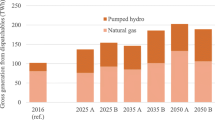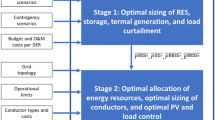Abstract
Electrical energy storage (EES) constitutes a potential candidate capable of regulating the power generation to match the loads via time-shifting. Optimally planned, EES facilities can meet the increasing requirement of reserves to manage the variability and uncertainty of renewable energy sources (RES) whilst improving the system operation efficiency and economics. In this work, the impact of intermittent RES on total production cost (TPC) is evaluated in the presence and absence of storage, using annual data regarding the non-interconnected power system of the island of Cyprus. Performing weekly simulations for the entire year of 2017, TPC is computed by solving the unit commitment based on a constrained Lagrange Relaxation method. Seven selected EES technologies are modeled and evaluated via a life-cycle cost analysis, based on the most realistic technical and cost data found in the literature. The results derived from the uncertainty analysis performed, show that zinc-air (Zn-air) battery offers the highest net present value (NPV). Lead-acid (Pb-acid) and sodium-sulfur (Na-S) are considered viable solutions in terms of mean NPV and investment risk. Lithium-ion (Li-ion) battery exhibits a particularly expensive choice. Dominated by its increased capital cost which still governs its overall cost performance Li-ion achieves a negative mean NPV far below zero. However, to strengthen the benefits derived from EES integration, further research and development is needed improving the performance and costs of storage. The uncertainty governing the majority of EES technologies, in turn, will be reduced, increasing their participation and RES contribution in autonomous power system operations.





Similar content being viewed by others
Abbreviations
- APR :
-
Annual profitable return
- C BM :
-
Base maintenance cost
- C BOP :
-
Balance of plant cost
- C E :
-
Emission cost
- C ENS :
-
Cost of energy not served
- C ESM :
-
Cost of energy storage medium
- C F :
-
Fuel cost
- C fO&M :
-
Fixed operation and maintenance cost
- C IM :
-
Incremental maintenance cost
- C M :
-
Maintenance cost
- C O&M :
-
Annual operation and maintenance cost
- C PCS :
-
Cost of power conversion system
- C SD :
-
Shut-down cost
- C SU :
-
Start-up cost
- CSU :
-
Cold start-up cost
- C vO&M :
-
Variable operation and maintenance cost
- DoD :
-
Depth of discharge
- E cap :
-
Energy capacity
- E d-y :
-
Total discharging energy per year
- h s :
-
Storage duration
- HSU :
-
Hot start-up cost
- i R :
-
Discount rate
- IPC :
-
Initial project cost
- J* :
-
Total relaxed cost
- λ :
-
Lagrange multiplier
- LCC :
-
Life-cycle cost of storage
- MD i :
-
Minimum down time of unit i
- MU i :
-
Minimum up time of unit i
- N :
-
Examined lifespan
- NPV :
-
Net present value
- η :
-
Round-trip efficiency
- η t i :
-
Active unit number of group j in period t
- η t imαχ :
-
Maximum unit number of group j in period t
- η t imin :
-
Minimum unit number of group j in period t
- P t i :
-
Power output of unit i at time t
- P imin :
-
Minimum operating limit of unit i
- P imax :
-
Maximum operating limit of unit i
- P loss :
-
Transmission loss
- P netD :
-
Net load demand
- P rated :
-
Rated power
- P RES :
-
Renewable generation
- P solar :
-
Solar generation
- P wind :
-
Wind generation
- q* :
-
Total cost corrected by ED
- RDG :
-
Relative duality gap
- RD i :
-
Ramp-down rate of unit i
- RU i :
-
Ramp-up rate of unit i
- SDR :
-
Self-discharge rate
- SR t :
-
Spinning reserve requirements at time t
- τ i :
-
Thermal time constant of unit i
- T i :
-
Duration of continuously OFF of unit i
- t i,cold :
-
Cold start time of unit i
- TPC :
-
Total production cost
- t d :
-
Down time
- t u :
-
Up time
- U t i :
-
Status of unit i at time t
References
Mahmutogullari, A.I., Ahmed, S., Cavus, O., Akturk, M.S.: The value of multi-stage stochastic programming in risk-averse unit commitment under uncertainty. IEEE Transact. Power Syst. (2019)
Kwon, H., Park, J.K., Kim, D., Yi, J., Park, H.: A flexible ramping capacity model for generation scheduling with high levels of wind energy penetration. Energies 9, 12 (2016)
Kuang, Y., et al.: A review of renewable energy utilization in islands. Renew. Sustain. Energy Rev. 59, 504–513 (2016)
Shirley, R., Kammen, D.: Renewable energy sector development in the Caribbean: current trends and lessons from history. Energy Policy 57, 244–252 (2013)
Nikolaidis, P., Poullikkas, A.: A comparative review of electrical energy storage systems for better sustainability. J. Power Technol. 97(3), 220–245 (2017)
Nikolaidis, P., Poullikkas, A.: Cost metrics of electrical energy storage technologies in potential power system operations. Sustain. Energy Technol. Assess. 25, 43–59 (2018)
Sheble, G.B., Member, S.: Unit commitment literature synopsis. Power Syst. IEEE Trans. 9, 1 (1994)
Padhy, N.P.: Unit commitment—a bibliographical survey. IEEE Trans. Power Syst. 19(2), 1196–1205 (2004)
Krishna, P.V.R., Sao, S.: Price based unit commitment problem under deregulation. Int. J. Sci. Eng. Technol. 184(1), 177–184 (2012)
Xie, Y.G., Chiang, H.D.: A novel solution methodology for solving large-scale thermal unit commitment problems. Electr. Power Compon. Syst. 38(14), 1615–1634 (2010)
Patra, S., Goswami, S.K., Goswami, B.: Differential evolution algorithm for solving unit commitment with ramp constraints. Electr. Power Compon. Syst. 36(8), 771–787 (2008)
Obi, M., Jensen, S.M., Ferris, J.B., Bass, R.B.: Calculation of levelized costs of electricity for various electrical energy storage systems. Renew. Sustain. Energy Rev. 67, 908–920 (2017)
Zhang, X., Xie, J., Zhu, Z., Zheng, J., Qiang, H., Rong, H.: Smart grid cost-emission unit commitment via co-evolutionary agents. Energies 9(10), 834 (2016)
Suazo-martínez, C., Pereira-bonvallet, E., Palma-behnke, R.: A simulation framework for optimal energy storage sizing. Energies 7(5), 3033–3055 (2014)
Feng, X., Liao, Y.: Electric power components and systems a new lagrangian multiplier update approach for lagrangian relaxation based unit commitment. Electr. Power Compon. Syst. 34, 5008 (2017)
Nikolaidis, P., Chatzis, S., Poullikkas, A.: Renewable energy integration through optimal unit commitment and electricity storage in weak power networks. Int. J. Sustain. Energy 37(10), 1–17 (2018)
CERA: Annual Report of Cyprus Energy Regulatory Authority. CERA, pp. 1–102 (2017). http://www.cera.org.cy
Dufo-lópez, R., Bernal-agustín, J.L.: Techno-economic analysis of grid-connected battery storage. Energy Convers. Manag. 91, 394–404 (2015)
Spanias, C.A., Nikolaidis, P.N., Lestas, I.: Techno-economic analysis of the potential conversion of the outdated moni power plant to a large scale research facility. In: 5th International Conference on Renewable Energy Sources and Energy Efficiency, pp. 208–220 (2016)
Nikolaidis, P., Chatzis, S., Poullikkas, A.: Life cycle cost analysis of electricity storage facilities in flexible power systems. Int. J. Sustain. Energy 13, 1–21 (2019)
Liu, Q., Wang, Y., Dai, L., Yao, J.: Scalable fabrication of nanoporous carbon fiber films as bifunctional catalytic electrodes for flexible Zn-air batteries. Adv. Mater. 1000, 3000–3006 (2016)
Author information
Authors and Affiliations
Corresponding author
Additional information
Publisher's Note
Springer Nature remains neutral with regard to jurisdictional claims in published maps and institutional affiliations.
Rights and permissions
About this article
Cite this article
Nikolaidis, P., Chatzis, S. & Poullikkas, A. Optimal planning of electricity storage to minimize operating reserve requirements in an isolated island grid. Energy Syst 11, 1157–1174 (2020). https://doi.org/10.1007/s12667-019-00355-x
Received:
Accepted:
Published:
Issue Date:
DOI: https://doi.org/10.1007/s12667-019-00355-x




